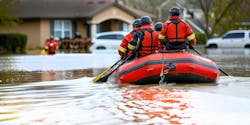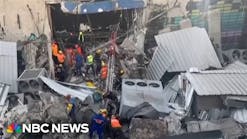Plastics are composed of organic materials that are part of a group of materials known as polymers. Polymers can be subdivided into two groups - naturally occurring and man-made. Common naturally occurring polymers include leather, wood, paper, silk, cotton and wool. Man-made polymers are created from organic materials found in nature. Approximately 53 billion pounds of synthetic polymers are manufactured each year in the United States alone.
Photo by Robert Burke The plastics used to manufacture automobiles generate thick, black smoke.
The American Society for Testing Materials (ASTM) defines a plastic as "a material that contains as an essential ingredient one or more organic polymeric substances of large molecular weight, is solid in its finished state, and at some stage in its manufacture or processing into finished articles can be shaped by flow."
The word polymer comes from the Greek "poly" (many) and "mer" (part). Therefore, a polymer is a compound with many parts. In reality, a polymer is a long-chained molecule composed of many smaller parts called monomers ("mono" is Greek for one). Monomers, however, are able to hook together into long chains of hundreds or thousands of parts. Such hooking is called polymerization.
In polymerization, monomers - which have double bonds - are broken down by heat or chemical reaction to single bonds. The single bonds attach to each other creating the self-reaction, which in turn creates the long chained polymer. This reaction usually takes place in a reactor vessel in a chemical plant under controlled conditions. But it can also take place during transportation or in storage, creating a hazard for emergency responders.
Man-made and naturally occurring polymers behave much the same way during reactions, especially when exposed to fire. In fact, some synthetic polymers contain the same elements as natural polymers, exhibit the same burning characteristics, and produce the same products of combustion - many of which can be toxic.
Naturally occurring polymers are standard in their identities - wood, for example, is not mistaken for cotton or wool. Synthetic polymers, however, are produced to conform to specific properties, and it may be difficult to distinguish between them. For example, polypropylene and polyethylene are very similar, as are styrene and styrene-acrylonitrile.
Photo by Robert Burke Much of the EMS and hazmat-response equipment used by firefighters are made of plastic or packaged in plastic.
Many terms are interchangeable when referring to synthetic polymers. The terms plastic, polymer, resin, compound and high-polymer macromolecular substance are used often used interchangeably.
Plastics are such a common part of our everyday lives that we don't give them much thought. They are found everywhere. Look around the room you are in - how many things are made of natural polymers and how many are synthetic?
As I type this column on my computer, I see that the housings for the computer as well as the keyboard, printer and monitor are made of plastic; the table the computer sits on is plastic; the chair I am sitting on is largely made of plastic and plastic fibers; the carpeting on the floor is made from plastic fibers; the telephone on the table is plastic; the cabinets next to the computer look like wood, but are actually plastic; the list could go on and on.
The jobs of emergency responders are made easier and safer because of plastics. Nearly all components of firefighter turnouts are made of plastic and plastic fibers; chemical suits, gloves and boots worn by hazmat technicians are made of plastic; ropes we use for rescue are made of plastic fibers; and many EMS supplies are either plastic or packaged in plastic. Again, the list could go on and on.
The polymer family tree has three distinct branches or divisions, and each branch may be identified by particular characteristics. Those branches are thermosets, thermoplastics and elastomers.
Thermosets are plastics that are hardened into their final shape in the manufacturing process by heating and usually cannot be softened again by heating without losing their identity. If attempts are made to re-form them by heat, they will start to burn. Those that can be softened by heating cannot be remelted or returned to their original form before they harden once again.
Common Examples Of Polymers
- Thermosets
- Thermoplastics
- Elastomers
- Epoxies
- ABS (acrylonitrile, butadiene and styrene)
- Butadiene
- Polyesters
- Nylons
- Natural rubber
- Polyurethane
- Vinyls
- Neoprene
- Silicones
- Acrylics
- Urethane
Thermoplastics are compounds formed by heat and pressure, then cooled into their final shape. They can be re-formed again if they are placed under heat or pressure, or both. In some cases, they can be heated and reformed up to 20 times without losing their properties.
Elastomers are sometimes called "synthetic rubbers" because of their elastic or rubberlike features. Natural rubber is also classified as a polymer that would be in the elastomer branch of the family tree. Synthetic rubbers were created to duplicate or surpass the most desirable properties of natural rubber. Elastomers are substances that at room temperature can stretch to at least twice, and in some cases many times, their original size and upon release return to their previous form with notable force. Elastomers cannot be heated and re-formed.
Manufacturing Plastics
The process of making plastics involves many different compounds and hazardous materials that are commonly shipped in transportation and stored in manufacturing facilities. One of the most common compounds used in the making of plastics is the monomer. Monomers can be found as solids, liquids or gases. Ethylene, which is used to make polyethylene plastic, is a colorless gas with a sweet odor and taste. It is also a highly flammable gas with a wide flammable range of 3%-36% in air. It is not considered toxic, but can displace oxygen in the air and create an asphyxiation hazard to response personnel. (Ethylene is also the gas that is produced naturally by ripening fruit and is used in orchards to hasten fruit ripening.)
Photo by Robert Burke A tank car containing a plastic solution is unloaded at a chemical plant. Tank cars can explode if inhibitors are separated from the monomers inside.
Styrene is another monomer from the aromatic hydrocarbon family, along with benzene, toluene and xylene. Also called vinylbenzene, it is a colorless, oily, aromatic liquid. Styrene is a moderate fire risk with a narrow flammable range of 1.1% to 6.1% in air. It is toxic by ingestion and inhalation and has a threshold limit value (TLV) of 50 parts per million (ppm) in air. Styrene monomer is used to make polystyrene, which is the rigid plastic from which soft-drink-cup covers are made. Polyacrylamide, a solid mono-mer white in color, is used to make the clear plastic from which compact discs are made.
Butadiene is another common, but dangerous monomer. It is a gas that is highly flammable and has a flammable range of 2%-11% in air. Butadiene is also a suspected carcinogen and has a TLV of 10 ppm in air. It is used in making elastomers and neoprene.
Nylon is a polymer having a high molecular weight. It is formed from adipic acid and hexamethylene diamine, which produces a material with high strength, elasticity, abrasion resistance and solvent resistance. Nylon is used to make tire cords, rope and apparel, and has other industrial and automotive uses.
Kevlar is a form of nylon that is used in some firefighter gloves and other safety products because of its great strength and resistance to puncture. Kevlar also has a high thermal endurance and doesn't start melting until it tops 950 degrees Fahrenheit.
Monomers cannot be shipped or stored unless they have been stabilized through the use of an inhibitor. The inhibitor prevents the uncontrolled polymerization of the monomer during transportation and storage. It does not interact chemically with the monomer, it just acts as a stabilizer. U.S. Department of Transportation (DOT) regulations prohibit the transportation of most monomers without the material being inhibited.
One of the changes to the 1996 North American Emergency Response Guide Book (NAERG) was the identification of materials in transportation that may undergo polymerization creating a danger to response personnel. When looking up a chemical by its four-digit identification number in the yellow section or alphabetically in the blue section of the book, you will be referred to a three-digit guide page in the orange section of the book. That number will have a "P" after it if the material in question has the potential to undergo polymerization.
You may also notice that next to the common shipping name of the material in the NAERG will appear the words "inhibited" or "stabilized." During an accident involving a rail car or tanker truck containing a mono-mer, the inhibitor can be separated from the monomer, enabling the monomer to undergo an explosive polymerization reaction that could cause the container to fail violently.
Once monomers and other chemicals are processed into plastic materials, they generally do not present any danger to civilians or emergency responders. Many plastic items, in fact, are used to sustain and improve the quality of life - artificial hearts, replacement joints, medical tubing and packaging.
The greatest concern for emergency responders, and particularly firefighters, is the burning of plastics. All plastics that contain carbon will burn. As with any materials that will burn, some are more combustible than others.
Chemicals can be combined with plastics during manufacture to reduce combustibility. Other plastic materials are formulated to be self-extinguishing. Plastics that contain carbon and hydrogen - such as polyethylene, polypropylene, polybutylene and polystyrene - burn very well. Burning polyethylene melts, smells like wax and produces dripping of the melted flaming material that could spread the fire. Polystyrene burns much slower, producing large soot particles, and smells like vinegar. Styrene is an aromatic hydrocarbon and they, as a family, burn sooty with incomplete combustion.
Plastics that are composed of carbon, hydrogen and oxygen burn slower than the others mentioned. Thermosetting plastics can produce burning smells like charred wood or formaldehyde. Those plastics that contain nitrogen and sulfur will produce very toxic gases when they burn. Plastics containing nitrogen burn with no smell, and those with sulfur produce a choking sulfur dioxide smell.
Those plastics that contain the halogens (fluorine and chlorine) produce acrid, choking odors when they burn. With fluorine- and chlorine-based plastics, the flame must be continuous or the plastic will self-extinguish. Almost all plastics can be made flame or smoke retardant by adding other chemicals during manufacturing. Adding any of the halogens will retard burning. Halogens are used with carbon to produce halon fire-extinguishing agents. Silicone-based plastics will not burn at all.
Flammable Products
When plastics burn, the rate of burn and amount of smoke generated can vary widely depending on the type of plastic and flame retardant chemicals present. Cellulose nitrate motion picture film was used for many years in Hollywood. Cellulose nitrate is highly flammable and ignites readily. Cellulose nitrate is made by reacting sulfuric acid and nitric acid on cellulose materials such as cotton. Cellulose nitrate plastics exhibit dangerous burning characteristics unlike any other plastic. When exposed to heat, the physical make-up of cellulose nitrate is changed in such a way that it may become subject to spontaneous combustion.
Combustion products produced when cellulose nitrate burns can be very toxic. Use of cellulose nitrate is not as widespread as it once was, but if encountered should be handled very carefully. New safer plastics have been developed to replace cellulose nitrates in such products as photographic and motion picture film and housewares. Teflon, on the other hand, another popular plastic, is not combustible at all and experiences heat damage only at extremely high temperatures.
Some plastics may exhibit unusual burning characteristics compared to building materials made from natural polymers such as wood. Plastics as a group generally have higher ignition temperatures than wood and other cellulose building products.
Plastics have been reported to have very high flame spread characteristics, as high as two feet per second, or 10 times that of wood on the surface. Vinyl when tested in a solid form in the laboratory has been shown to burn slowly. However, when in the form of a thin coating on wall coverings, it spreads rapidly contributing to flame spread.
Nylon has a tendency to self extinguish when a flame is removed. When nylon is in the form of carpet fiber under certain conditions it burns with great enthusiasm. Polyurethane foam that has not been treated with a flame retardant is very flammable. It is used as an insulating material in construction and burns with a very smoky flame. Because of its burning characteristics, it has contributed to rapid flame spread in several fatal fires.
Burning of plastics may produce large quantities of thick, black smoke. When chemicals have been added to retard burning, they may actually expand the amount of smoke that is produced. Because of their ability to melt and run, plastics can spread fires in ways that could mislead fire investigators. When skylights and light fixture diffusers are ignited by high ceiling temperatures, they may soften and sag. They can fall into combustible materials below and start fires in several isolated locations. This could lead an investigator to suspect an incendiary fire when in fact it was not.
Dangers To Firefighters
The products of combustion when plastics and other materials burn is the most significant hazard to both occupants of a building and firefighters during a fire. Plastic materials that contain only carbon and hydrogen in their formulation will generate only carbon, carbon monoxide, carbon dioxide and water as they burn.
Intermediate products of combustion, however, also are produced and can include acrolein, formaldehyde, acetaldehyde, propionaldehyde and buryraldehyde. Members of the aldehyde hydrocarbon family are irritants and flammable, with wide flammable ranges. Acrolein and carbon monoxide are lethal poisons. In addition to being toxic, carbon monoxide is also extremely flammable.
Examples of carbon- and hydrogen-based plastics include polyethylene, polypropylene, and polystyrene. Combustion products produced from burning plastics containing only carbon and hydrogen are the same as natural polymers such as wood, paper and other Class A combustible materials. Plastics containing carbon, hydrogen and oxygen produce the same combustion products as those containing just carbon and hydrogen. The major difference is these plastics tend as a group to be less combustible than those with just carbon and hydrogen. Plastics in this group include acetal, acrylics, alyls, cellulosics, some epoxies, ethylene vinyl acetate, ionomers, phenolics, polycarbonate, polyesters and polyphenylene oxide. When nitrogen is added to the plastic compound, an additional product of combustion occurs when it burns.
Another product of combustion is hydrogen cyanide, an extremely toxic and flammable gas. Just like carbon monoxide, much of the hydrogen cyanide is consumed by the fire as it is produced. (It must be noted that hydrogen cyanide is also generated by the burning of the natural polymers including, leather, wood, silk and some types of paper.)
Plastics that contain fluorine and chlorine are generally less combustible than other plastics. As they decompose when exposed to the heat of a fire, they produce hydrogen fluoride and hydrogen chloride gases, respectively. Both are corrosive gases that can form acid when in contact with moisture, such as in the eyes, skin or lungs.
Plastics containing fluorine include fluoroplastics, of which Teflon (polytetrafluoroehtylene) is the most common. Chlorine containing plastics include polyvinyl chloride (PVC), polyvinyl dichloride and polyvinylidene chloride. Plastic compounds can also contain sulfur, which will decompose to sulfur dioxide during the combustion process. It is a strong irritant and can be lethal when exposed to concentrations of 100 ppm for more than 10 minutes. Plastics that contain sulfur include polysulfone and polyethersulfone.
Firefighters who wear self-contained breathing apparatus (SCBA) will be protected from carbon monoxide and other toxic fire gases. Many of these gases are invisible and remain present even after the smoke is "cleared." Firefighters should continue to wear SCBA during overhaul operations and not remove them until they are outside the fire building or until the air has been monitored within the building and shown to be safe.
It is also important to remember that the same toxic materials inside the fire and smoke can become impregnated in firefighter turnouts. Each time the unwashed turnouts are worn, the firefighter is re-exposed to the toxic substances in the turnouts. Firefighter turnouts should be washed or decontaminated to help prevent this continued exposure to toxic materials.
Robert Burke, a Firehouse® contributing editor, is the fire marshal for the University of Maryland and has served on state and county hazmat response teams. Burke is a veteran of over 17 years in career and volunteer fire departments, serving as assistant chief and deputy state fire marshal. He holds an associate's degree in fire protection technology and a bachelor's degree in fire science, and is pursuing a master's degree in public administration. Burke is an adjunct instructor at the National Fire Academy and Maryland Fire and Rescue Institute, and is the author of the textbooks Hazardous Materials Chemistry For Emergency Responders, published in 1997, and Counter-Terrorism for Emergency Responders, to be published this year. He can be reached on the Internet at [email protected].







